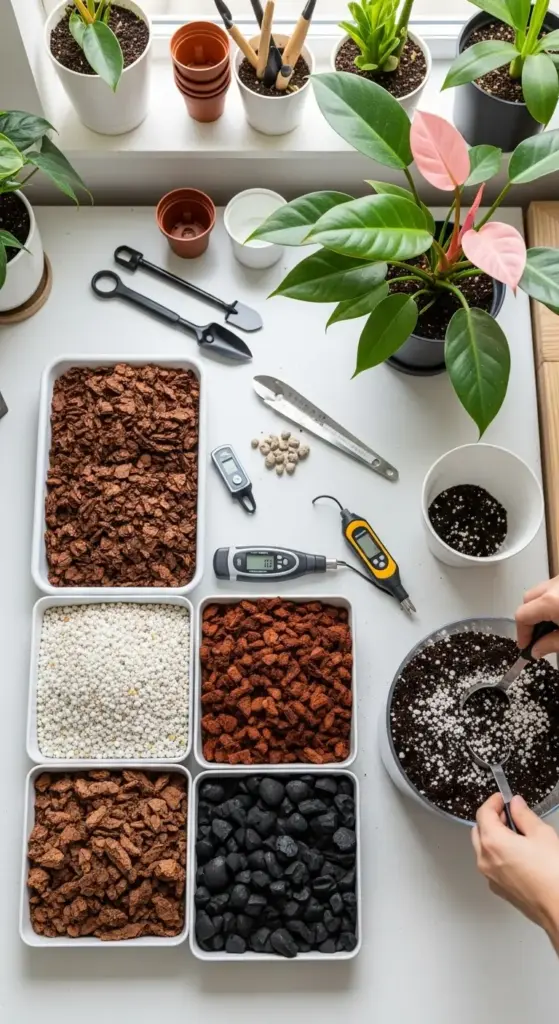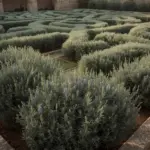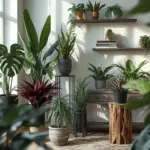5. The Soil Mix Recipe That Plant Forums Keep Secret

I killed my first two Pink Princess plants with what I thought was “premium” potting soil. Turns out, that $15 bag of fancy mix was basically plant quicksand for my expensive babies.
After losing $400 worth of plants to root rot, I finally cracked the soil code that serious collectors guard like state secrets.
Why Regular Potting Soil Is Plant Poison
Standard potting mixes retain way too much moisture for Pink Princess roots, which need to breathe between waterings. Most commercial soils are designed for outdoor annuals, not tropical aroids.
I watched my beautiful variegated leaves turn yellow and drop while the “moisture control” potting mix kept the roots soggy for weeks. It was heartbreaking.
The problem is peat moss and vermiculite – ingredients that hold water like sponges. Pink Princess roots need fast-draining, chunky media that allows air circulation around the root system.
Regular potting soil also lacks the organic matter that aroids crave in their natural environment. Your plant slowly starves even while sitting in “nutrient-rich” soil.
My Secret Ingredient Ratios That Actually Work
After months of experimentation, I developed this exact recipe that creates perfect drainage and nutrition: 40% bark chips, 25% perlite, 20% coco coir, 10% worm castings, and 5% activated charcoal.
This combination mimics the chunky, well-draining forest floor where Pink Princess grows naturally. The bark provides structure, perlite adds drainage, and coco coir holds just enough moisture.
The worm castings are pure gold – they provide slow-release nutrients without burning delicate roots. I get mine from a local fishing supply store for half the price of garden centers.
Activated charcoal prevents soil from going sour and helps filter out impurities. It’s like having a tiny water treatment plant in your pot.
Where to Source Ingredients Without Going Broke
Orchid bark from hardware stores costs 60% less than the same stuff sold as “aroid mix” at specialty plant shops. I buy the medium-grade chunks at Home Depot.
Perlite is cheapest at farm supply stores – a huge bag costs what you’d pay for a tiny container at the garden center. Just make sure it’s horticultural grade, not construction grade.
For coco coir, I buy compressed bricks online in bulk. One brick expands to fill a 5-gallon bucket and costs less than a small bag of pre-expanded coir.
Worm castings from fishing stores are pure and cheap. Avoid the garden center stuff that’s often mixed with regular compost and doesn’t provide the same benefits.
The Mixing Process That Prevents Problems
Always rinse your bark chips before mixing – they often contain dust and small particles that can clog drainage. I soak mine overnight, then rinse until the water runs clear.
Pre-moisten the coco coir separately before adding it to the mix. Dry coir repels water initially and can create hydrophobic pockets in your soil.
I mix everything in a large plastic tub, adding ingredients gradually while stirring. The final mix should feel chunky and well-draining when you squeeze a handful – it should crumble apart, not hold together.
Test the drainage by watering a small sample in a clear container. Water should flow through quickly, not pool on top or drain too slowly.
Modifying Store-Bought Mixes for Better Results
If you’re stuck with commercial potting soil, you can salvage it by adding 50% bark chips and perlite to improve drainage dramatically.
Remove any large pieces of wood or bark that look decomposed – these create anaerobic pockets where harmful bacteria thrive.
I also add a handful of activated charcoal to every bag of modified commercial mix. This helps neutralize the pH and prevents soil from becoming acidic over time.
For emergency situations, even adding 25% perlite to regular potting soil makes a huge difference in drainage and root health.
pH Testing That Actually Matters
Pink Princess thrives in slightly acidic soil with a pH between 5.5 and 6.5. Most commercial potting mixes are too alkaline, which locks up nutrients even when they’re present.
I use a simple digital pH meter that costs about $15 online. Soil test strips are unreliable and often give false readings in organic-rich mixes.
To test accurately, mix 1 part soil with 2 parts distilled water, let it sit for 30 minutes, then test the liquid. This gives you the true pH your plant’s roots experience.
If your mix tests above 7.0, add a small amount of sulfur or use rainwater for watering to gradually lower the pH naturally.
Adjusting pH Without Killing Your Plant
Sulfur is the safest way to lower pH gradually – it works slowly and won’t shock your plant’s root system. I mix about 1/4 teaspoon per gallon of soil.
Never use vinegar or lemon juice to acidify soil – these create temporary pH swings that stress plants and can burn roots.
For raising pH (rarely needed), I add a tiny pinch of agricultural lime. But honestly, if your mix is too alkaline, it’s easier to start over with better ingredients.
The key is making gradual adjustments over months, not trying to fix pH problems overnight.
The Drainage Test That Saves Plants
Here’s my foolproof drainage test: water your freshly potted plant thoroughly, then check how long water takes to stop dripping from drainage holes.
Good aroid mix should stop dripping within 10-15 minutes after watering. If it’s still dripping after 30 minutes, your mix retains too much water.
I also do the “squeeze test” – grab a handful of moist soil and squeeze it. It should crumble apart when you open your hand, not hold together in a clump.
If your mix fails these tests, add more bark chips and perlite until it passes. It’s worth repotting to get the drainage right.
Signs Your Soil Mix Is Working
Healthy Pink Princess roots should be white or cream-colored with firm texture when you check during repotting. Brown, mushy roots indicate drainage problems.
New growth emerges consistently when your soil provides proper aeration and nutrition. Stunted growth often means compacted or nutrient-poor soil.
The soil should dry out partially between waterings but never become bone dry. You want that perfect balance of moisture retention and drainage.
Your plant should also show improved variegation and stronger stems when growing in proper aroid mix versus regular potting soil.
The Results That Made Me a Soil Convert
After switching to my custom soil recipe, my Pink Princess went from barely surviving to absolutely thriving. Root health improved dramatically within just one repotting cycle.
I haven’t lost a single plant to root rot since developing this mix three years ago. The difference in plant health is honestly night and day.
My plants also grow faster and produce better variegation in this chunky, well-draining mix. The investment in quality ingredients pays for itself in healthier, more valuable plants.
Common Soil Mistakes That Kill Expensive Plants
Using garden soil indoors is plant suicide – it’s too heavy, retains too much water, and often contains pests or diseases.
Reusing old potting soil without refreshing it leads to compacted, nutrient-depleted growing medium that suffocates roots.
Another killer mistake: not checking drainage before planting. Always test your soil mix in a separate container before trusting it with expensive plants.
And please, never add sand to improve drainage. Sand actually makes drainage worse by creating concrete-like conditions when mixed with organic matter.
Think you’ve got the soil dialed in? The watering technique I’m about to share will blow your mind. Click “next” to discover the bottom-up watering method that prevents root rot 100% of the time – this technique saved my most expensive plant and completely changed how I think about hydration!









GIPHY App Key not set. Please check settings